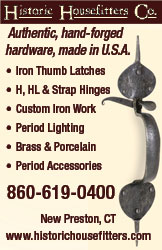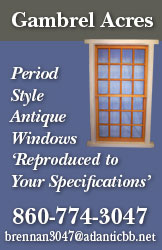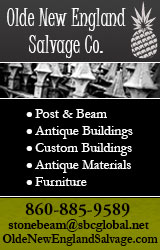Home Structural Products & Services, Stairlifts Structural Products & Services, Stairlifts Furniture, Clocks,
Accessories
Reclaimed Stone Materials
Woodwork, Blinds,
Finishing
Lighting
Kitchen
Floors & Rugs
Fabrics
Paint & Wallpaper Pottery & Tile
Period Hardware Antiques, Folk Art,
Fine Art, Auction Houses
Windows
Interior Design & Architecture
Silver, Cookware, Pewter
Garden
Historic Hotels |
JIM LAURINO

|
This scene overlooks the Connecticut River from high-ground in East Haddam.“Society Hall” (main building - foreground) is now an Antiques shop, and the porch out front is filled with old dressers, signage, and shelves of old stuff! |
Jim studied painting, design, and color theory at the University of Connecticut. Through more recent workshops and self-study, Jim has cultivated a bold representational painting style that balances the impressionists influence with contemporary subject matter. His expressive application of paint, married with a keen eye for classic New England scenes, charms the viewer and truly makes his work unique. Jim features older homes in many of his landscapes which he typically executes “En Plein air” (onsite using an easel setup). Occasionally, homes are the main point of interest, but they often serve to guide the viewer through a painting. Using man-made structures as directional planes, or sources of light and shadow, help him to enhance an otherwise natural landscape.
Jim constructs frames for all of his paintings. The frames, which are made out of reclaimed wood material, fashion a rustic window into each piece, subtly complimenting his work. A brief write-up of Jim’s approach to painting and framing was featured in Plein-Air magazines’ Dec-Jan 2018 issue.
Jim’s paintings are in numerous private collections. He shows his work in galleries throughout the nutmeg state, and enjoys participating in competitive events across the Northeast. Most recently, he received a first place award for his work in the 2020 Hudson Valley Plein Air festival, and received the Artists choice award for his work at the Parrsboro, NS plein air event in 2019.
For more information about the artist please visit: www.jimlaurino.com. |

|
Benjamin Hanks, a drummer in the Revolutionary War, was a clockmaker and silversmith, known for his church bells, who settled in Litchfield from 1779 to 1790. The blue entryway depicted in this painting is a late addition to the home he built in 1780. The house now contains three apartments but also served for a time as the Park Hotel.
Across the street is the wing of a home built in 1807, a prime example of New England Federal period Architecture. According to local lore, one Mayor Mathews, the royalist mayor of New York, was held hostage here. It is said that one day he presented his carriage to the Seymour family (residents and guardians), and “walked abroad for the benefit of the air”, never to be seen again! |
Currently on exhibit with the 2021 Academic Artists Association’s traditional realism show, this collection of buildings presented an interesting composition. I was drawn to the shadows which danced across the white farmhouse (dates from the 1800s). |

|

|
The “Center Hotel” is located in the center corners historic district of Harwinton, Connecticut. Harwinton has the highest concentration of historic homes in the state, and although the house could use a paint job, this one is a beauty. The building is a striking example of Federal Period Architecture (popular 1780 – 1820). It is listed as being constructed in 1820, but viewed from the side and back of the home, you can see that the façade was attached to a much older structure, dated ~1760. There is not a lot of written material on the building,but it was presumably a hotel two centuries back. At that time Litchfield was a commercial hub, and this building fronts a major route headed into that town. The scene was painted from sketches done on-site, and some photographs. |
The Glebe House dates from 1740, and is an example of Georgian colonial architecture. It was the home of Woodbury’s first Anglican minister and his family, and is now a museum. |

|

“Old Litchfield, CT”19x30 Oil/Canvas, Available
|
A set of three historic homes facing west on Old South Road in town, the oldest of which dates from 1761 (depicted here as the mustard colored home on the right; no wreath). That building was constructed by the Marsh family on a site which contained the home of one of the first town settlers (John March). There was an apple orchard that stretched behind these three houses, and some of these very old trees are still alive. |
|
|

 

  

 
  


|

 Structural Products & Services, Stairlifts
Structural Products & Services, Stairlifts